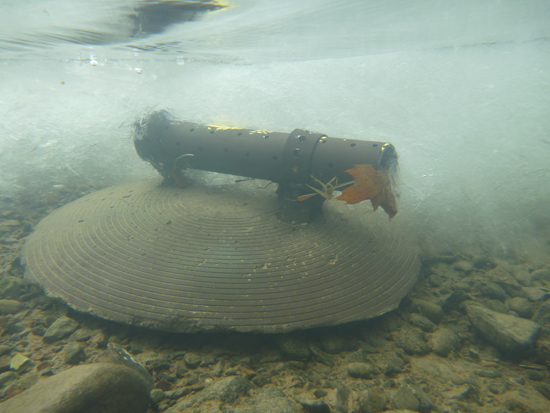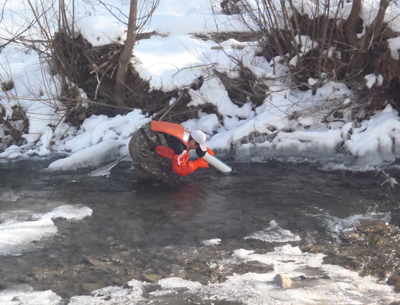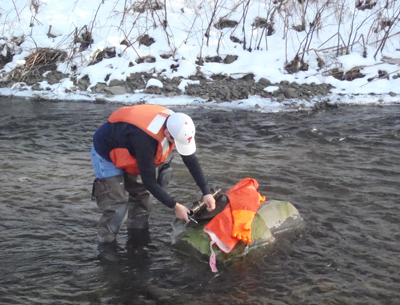Delaware • New Jersey • Pennsylvania
New York • United States of America
- Background
- Reanalysis of Frozen Samples
- HOBO® Continuous Conductivity Meters
- Collection of New Biological Samples
- Baseline Monitoring Toxicity Tests
- Radiochemistry Monitoring
- Additional Resources
In May 2010, DRBC Commissioners unanimously approved a Resolution for the Minutes that directed staff to develop draft regulations specific to natural gas development for public notice and comment rulemaking and postponed the Commission's consideration of well pad dockets until regulations are adopted.
The Commissioners subsequently decided to postpone adoption of regulations in November 2011 and continued to confer to reach consensus on a path forward that provides for the development of a potentially valuable energy source while protecting the basin's vital water resources.
As a result of the postponement in 2011, DRBC staff recognized that there was a limited window of opportunity to characterize pre-gas drilling baseline conditions in the upper section of the Delaware River Basin.
By establishing pre-gas drilling conditions, DRBC is in a stronger position to minimize impacts from gas development and to compel remedial action if impacts do occur.
This is especially important since, in this region, the Marcellus Shale underlies the Commission's Special Protection Waters drainage area, where regulations require no measurable change to the existing high water quality.
The main focus areas for baseline characterization included:
- Reanalysis of frozen samples for hydraulic fracturing-related parameters;
- Deployment of HOBO® continuous conductivity meters;
- Collection of new biological samples to fill gaps in existing monitoring efforts;
- Evaluating toxicity tests for monitoring; and
- Radiochemistry monitoring of the upper and middle Delaware River.
Over the years, the DRBC has worked with the Academy of Natural Sciences of Drexel University, Philadelphia, Pa., to perform analytical testing on samples collected as part of the Commission's routine monitoring programs.
One such program is the Scenic Rivers Monitoring Program (SRMP), an effort for which the DRBC and the National Park Service (NPS) partner to monitor and manage the water quality in the Special Protection Waters and National Wild and Scenic River segments of the non-tidal Delaware River.
Over 700 samples collected by DRBC in 2009 and 2010 as part of the SRMP were frozen by the Academy in a process called archiving. Thanks to funding from the NPS and the Haas Foundation, DRBC contracted with the Academy to thaw the archived samples and reanalyze them for chemical parameters related to hydraulic fracturing, such as barium and strontium.
The Academy performed this work, and DRBC now has a strong database of pre-gas drilling concentrations of important hydraulic fracturing indicator parameters.
Figure 1. Ranges of barium concentrations at key water quality monitoring locations in the upper and middle Delaware River Basin.
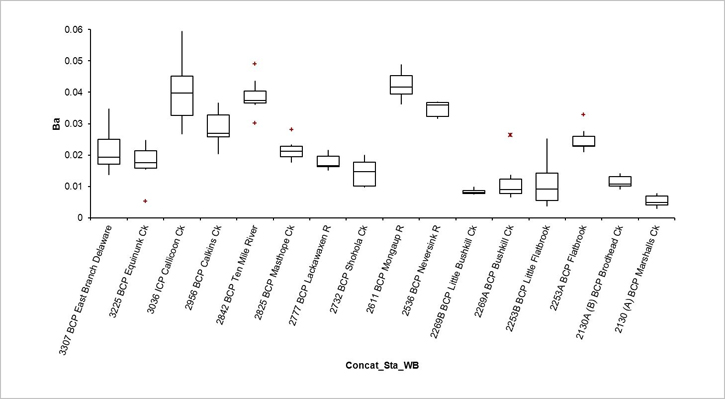
To further strengthen its baseline dataset, DRBC also worked with the Academy to reanalyze SRMP samples collected in 2011 for chemical parameters related to hydraulic fracturing.
In order to better protect the existing high water quality of the region, DRBC deployed HOBO® monitors in six locations in the upper Delaware watershed (the Delaware River at Callicoon, West Branch Lackawaxen, and Equinunk, Oquaga, Shehawken and Middle Branch Dyberry creeks) to collect continuous water quality data that will provide a better understanding of baseline conductivity and temperature ranges over a variety of flows and conditions before any natural gas development activities begin in the basin.
Specific conductivity is a measure of how easily an electrical current can pass through water. This parameter can be easily measured and recorded with a meter, and it is especially sensitive to the salts and ions that are defining characteristics of hydraulic fracturing fluid. Significant changes in conductivity can indicate the presence of a discharge or other type of pollution in the stream.
The data collected from the HOBO® monitors will allow DRBC to better differentiate between conductivity spikes that may arise due to natural gas drilling-related activities versus background conditions.
DRBC staff especially wanted to measure conductivity through the winter months, since road de-icing with salt could cause a short term rise in specific conductivity unrelated to natural gas development.
The meters were deployed from the spring of 2012 until the fall of 2014; during that time, DRBC collected enough data to establish sufficient background conditions.
DRBC now has year-round specific conductivity data at key water quality management locations, which will be useful for comparison to post-gas development specific conductivity values and for setting thresholds that might indicate that a spill has occurred if natural gas drilling commences in the Delaware River Basin in the future.
View additional photos of HOBO® Conductivity Monitoring on DRBC's Flickr page.
One advantage of biological monitoring is that it integrates all the stresses at a given monitoring site.
If a spill occurred in a flowing stream, chemistry samples collected days or hours after the spill might not show any evidence of the spill having occurred.
However, the biological community at that location could continue to exhibit signs of the impact for many months. In addition, biological communities are sensitive to milder changes associated with land disturbance and impacted flow and temperature regimes.
In 2010, DRBC compiled all available biomonitoring data in the upper portion of the basin to see where there were gaps in the data. Funded by a grant from the Haas Foundation, DRBC staff collected new biological monitoring samples at over 100 locations in Pennsylvania and New York in the spring and summer of 2011.
These new samples, collected using state-specific monitoring protocols, provide a strong baseline from which to define pre-gas drilling biological conditions.
Figure 2. New samples collected by DRBC (circles), which will be added to the older samples (triangles).
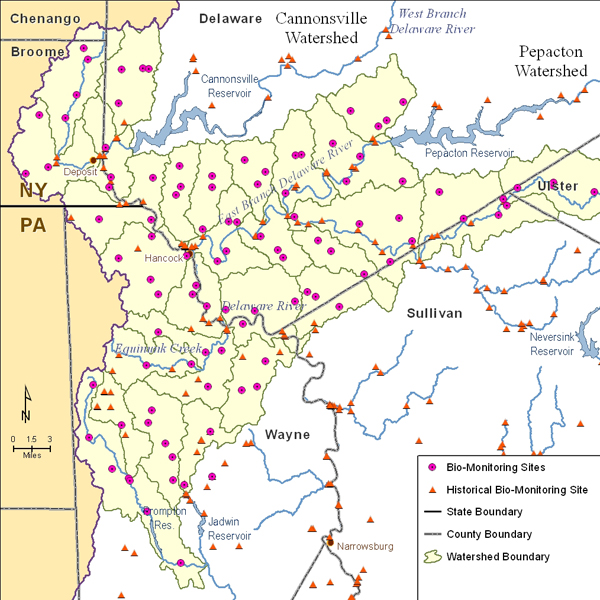
Additional information was needed on methodologies and procedures to demonstrate compliance with the applicable basinwide effluent limitations and basinwide stream quality objectives in current and proposed DRBC water quality regulations when applied to toxicity in low hardness and low alkalinity surface waters of the basin that will be potentially exposed to releases of flowback/production water.
This study evaluated whether or not selected toxicity test methods (acute, short‐term chronic and whole‐life cycle chronic) and species (fish, algae, daphnia and mayfly) are appropriate to measure baseline ambient water conditions, to monitor cumulative effects of natural gas development in surface water (including accidental releases) and to monitor wastewater from treatment plants receiving flowback/production water.
In this project, the DRBC worked with Stroud Water Research Center and American Aquatic Testing (AAT) to strengthen the protection of basin water quality by evaluating appropriate tests to measure baseline ambient water conditions and their use in assessing any potential impacts from natural gas development through the characterization of toxicity in effluents and surface waters.
- Baseline Monitoring Toxicity Tests Summary Report (pdf 206 KB)
- Stroud Water Research Center:"Ecotoxicity Study for Mayflies Exposed to Ambient Stream Water from the Upper Delaware River Basin, Reference Toxicant, and to Produced-Water from Natural Gas Drilling" (pdf 1.4 MB)
- AAT: Ambient Water Toxicity Tests - Standard Species - USEPA Methods (pdf 1.7 MB)
- AAT: Sodium Chloride Reference Toxicant - Standard Species (pdf 2.5 MB)
- AAT: Produced Water Toxicity Tests - Standard Species - Dyberry Creek Water (pdf 2.3 MB)
- AAT: Produced Water Toxicity Tests - Standard Species - White Clay Creek Water (pdf 2.4 MB)
The Commission realized that information was also needed to characterize background (pre-commencement of hydraulic fracturing) naturally occurring radioactive materials (NORMs).
Under this project, supported by funding from the William Penn Foundation, DRBC collected baseline radiochemistry data. This helped strengthen the protection of Delaware River Basin water quality against impacts from natural gas development.
For this investigation, DRBC performed one year of quarterly monitoring for radiochemistry, including alpha and beta emitters, radium‐226 and radium-228 at 32 water quality control points in the upper and middle Delaware River Basin.
The survey kicked off January 17, 2014, with staff collecting surface water samples from various bridges crossing the Delaware River.
-
Monitoring for Baseline Radiochemistry before Natural Gas Development in the Delaware River Basin (October 2015; pdf 828 KB)
Report:
Baseline Monitoring Summary Report for the Delaware River (pdf 3.4 MB; March 2017)
Presentation:
Presentation to the DRBC Monitoring Advisory Committee: Status of Baseline Monitoring in the DRB Before Natural Gas Development (pdf 5 MB; 2013)
View Presentation as YouTube Recording
Related Information:
Copyright © Delaware River Basin Commission,
P.O. Box 7360, West Trenton, NJ 08628-0360
Phone (609)883-9500; Fax (609)883-9522
Thanks to NJ for hosting the DRBC website
